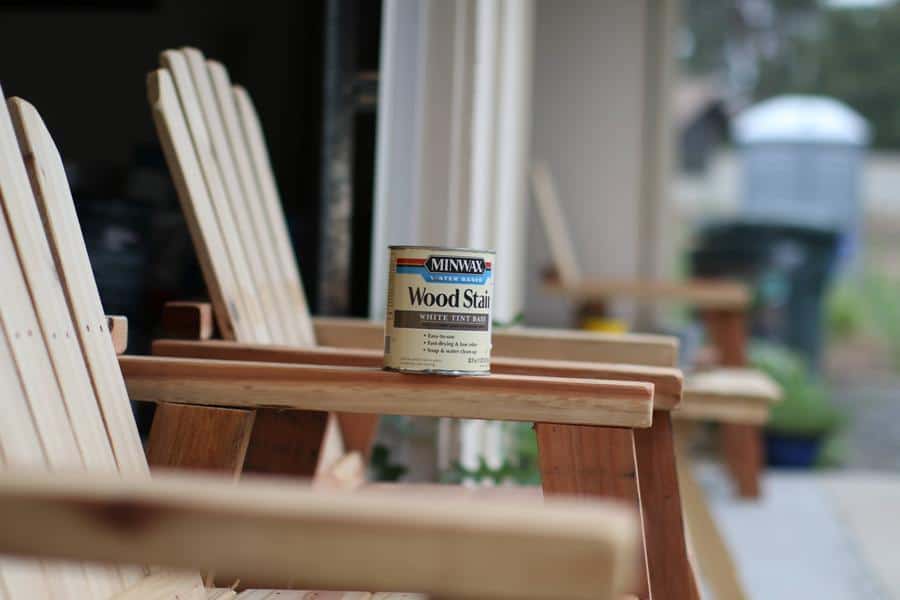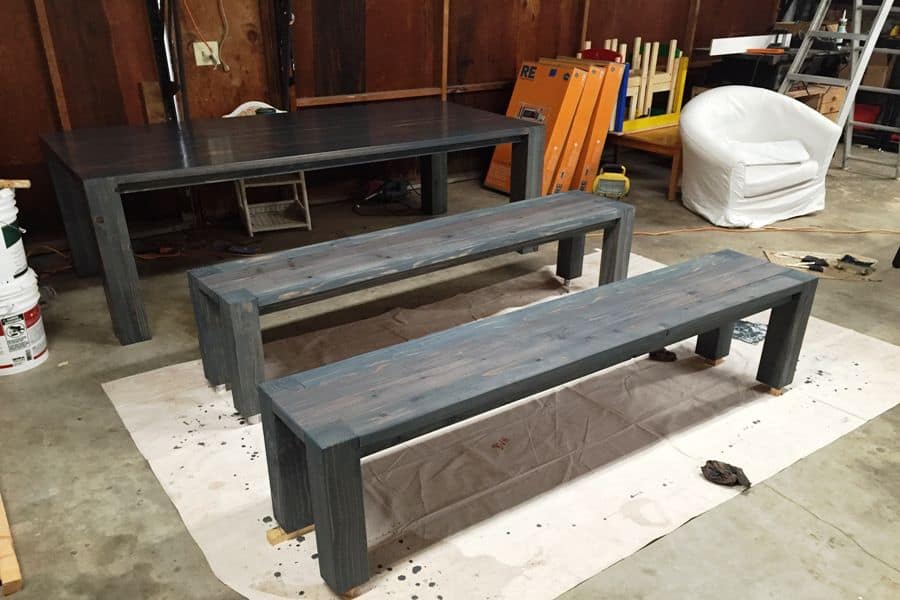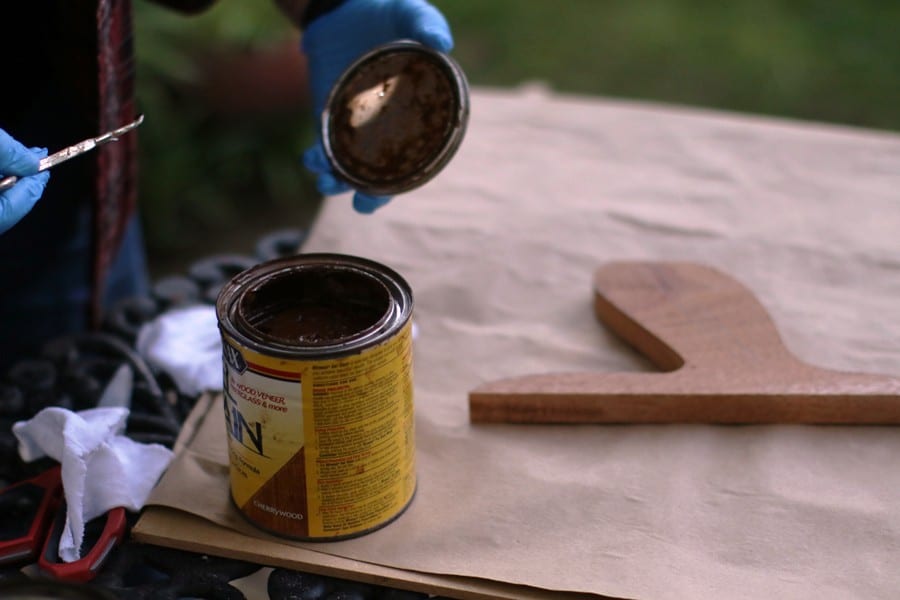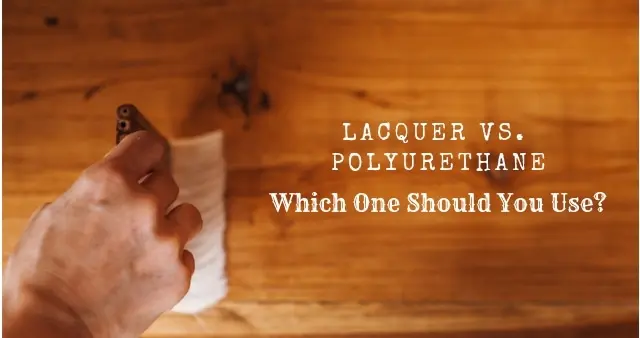Wood stain imparts beautiful and rich colors to wood, but the odor it produces is unpleasant, and can be harmful to your health. Read this article to learn why stains smell and which stain smells are toxic. Then, follow the detailed instructions for two strategies that will rid your home of stain smells.
Contents
Getting Rid of Wood Stain Smell
Wood stains contain various chemicals that emit strong smells. After you stain indoors, the smells tend to linger. Exposure to strong stain smells is unpleasant, and can make your eyes water or itch, your nose run, and leave you with a sore throat.

As opposed to water-based, oil-based stains contain harmful chemicals like acrylic and urethane, which emit VOC’s that are damaging to breath in. These wood stain fumes are toxic.
Before we cover the strategies for getting rid of wood stain smell, it is helpful to understand why stains smell.
Why Do Stains Smell?
Stains are made up of pigments and dyes, suspended or mixed with oil or acrylic resin and a solvent. As the solvent evaporates, the pigments and dyes bond to the wood, and the stain dries. The smell of stain is actually the smell of the evaporated solvent lingering in the air.
Some solvents, and some stains, have a harsher or stronger smell than others.
Water is the solvent in water-based stains. Once the water has evaporated and the stain is dry, there should be no smell to speak of.
Non-grain raising stains, also called alcohol stains, use alcohol as the solvent. The smell is noticeable.
The biggest culprits when it comes to persistent, pungent odors are oil-based stains.
- While these stains are generally more durable and longer lasting than water or alcohol stains, they are also stinkier.
- Not only that, the solvents take longer to evaporate, extending the dry time and the amount of time that the smelly solvent is being released from the wet stain into the air.
Mineral spirits are generally the solvent of choice when it comes to oil-based stains. A drying oil such as linseed oil is also usually present, helping the colorant bind to the wood, and this is also responsible for some of oil stain’s distinctive scent.
The other ingredients in oil-borne stain are metallic salts and thickening agents. Thickening agents are developed by the manufacturer, and are usually withheld from the ingredients list for reasons of propriety.
Use Ventilation to Get Rid of Wood Stain Smell
Exchanging clean, fresh air for solvent-saturated air is one of the quickest and easiest ways to rid a space of lingering stain smell. Follow these tips for a reasonably quick and remarkably effective reduction in smell.

- Choose your workspace wisely. Staining outdoors is the best way to allow stain smell to dissipate quickly. A workshop with a ventilation system is the second best choice. You can also stain in your garage with the door open – set up your project near the doors for the best circulation. If you must stain indoors, choose a large room with many windows and/or doors.
- Turn off recycled air. Many air conditioning systems work most efficiently when they recycle the air already inside the home, rather than pulling in warmer air from outside. When the air in your home is full of evaporated solvents from staining, this energy-saving feature just spreads the stain smell throughout the house. Switch your air conditioning system from recycled air mode to fresh air mode, if possible. If not, turn it off entirely.
- Increase fresh air flow. Opening windows and doors to the outside world will help encourage the exchange of air, diluting the stain smell and carrying it out of your home. Windows or doors situated across the room or house from each other can be used to create a cross-breeze, which efficiently exchanges the stain-laden atmosphere you’ve created in your house for fresh air.
- Add fans. Set up fans in or in front of windows, blowing air out rather than sucking air into the room. This is sometimes labeled as ‘exhaust mode’. A fan or two set up to blow horizontally across your workpiece will carry the stain smell away from your workpiece, speeding dry time slightly and helping the smell dissipate.
Understand that increasing air flow over your work surface will help dissipate the smell, but it will also increase the amount of dust and debris that can land on your work piece. You’ll need to sand the work piece prior to finishing.
Use Odor-Absorbing Material to Get Rid of Wood Stain Smell
Baking soda, activated charcoal, and distilled vinegar all have the ability to absorb and trap odors emitted by stain.
- Choose your substance. You likely have baking soda around the house, perhaps even absorbing odors in your fridge. For maximum efficacy, use a fresh box rather than one that has already started soaking up smells. Activated charcoal, often used in water filtration, is a very dry substance that absorbs odors quickly. It can be found in pet stores and some drug stores. Distilled white vinegar can be purchased in drug stores and is also effective at absorbing and trapping odors of all kinds.
- Source containers. Whatever substance you choose, you want to maximize the surface area that is exposed to the air. This increases the amount of odor that the material will be able to absorb, ridding your home of stain smell more quickly. Shallow dishes are preferably to narrow-mouthed containers because they maximize the amount of the odor-absorbing substance that is in contact with the air.
- Place the containers strategically. Several small containers are more effective than one large container. Place some of the containers close to your workspace or stained workpiece, scattering others around the room and in the corners.
- Change the material (if necessary). Between two and twelve hours after setting out baking soda, you should observe a noticeably lowered odor. If the smell isn’t quite gone yet, replace the used baking soda or distilled vinegar with fresh ingredients. Activated charcoal continues to absorb smells for up to a month.

Can I Avoid Wood Stain Smell?
Staining in an open area or outdoors is the best way to avoid lingering stain smells. When possible, choose an open area like a garage, where you don’t spend much time. Staining outdoors, whether under a carport, in your driveway, or on a tarp in the backyard, is another great way to ensure wood stain smells don’t enter your home.
A water-based stain is the best choice if you’re looking to avoid wood stain smell altogether. The solvent in these mixtures is water, so the smell is minimal and dissipates quickly.
Exterior oil-based stain products include mildewcides to prevent mold and fungus from growing in and on the wood. This adds to the smell of the stain and can be hazardous to your health, so it’s best to keep them outside. Some water-based stains may also contain mildewcides, so be sure to check the label before using them inside.
If you’re staining wood floors, plan for the home to be empty for up to four days. In ideal weather, the project is likely to last no longer than two or three days. High humidity and high temperatures slow the dry time of stain and protective finishes, and you don’t want to have to move back into a space that stinks.
Are Wood Stain Fumes Toxic?
Volatile organic compounds (VOCs) are emitted by many wood products, including oil-based stains with acrylic or urethane binders. VOCs degrade the air quality indoors, and cause a range of health problems. Breathing issues, headaches, and nausea are a few of the symptoms caused by VOC exposure.
While staining, wear a respirator-type mask to protect your airways, and don safety goggles to prevent exposure to your eyes. This will also help protect you from any accidental splashes during the staining process.
If you get any wood stain on your skin, make sure to remove it quickly.
As consumers have become more aware of VOC-releasing products and the EPA has issued standards for the level of VOCs a household product can emit, manufacturer’s have responded. Low or no VOC wood stain formulations are now widely available.
Conclusion
Wood stains emit unpleasant smells that can degrade the air quality indoors, causing health concerns. These smells are the result of evaporation as the stain dries. Get rid of stain smells using odor-absorbing products like distilled vinegar, baking soda, or activated charcoal, or by increasing and improving the ventilation in your workspace.
